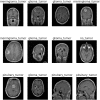Enhancing brain tumor diagnosis: an optimized CNN hyperparameter model for improved accuracy and reliability
- PMID: 38660148
- PMCID: PMC11041936
- DOI: 10.7717/peerj-cs.1878
Enhancing brain tumor diagnosis: an optimized CNN hyperparameter model for improved accuracy and reliability
Abstract
Hyperparameter tuning plays a pivotal role in the accuracy and reliability of convolutional neural network (CNN) models used in brain tumor diagnosis. These hyperparameters exert control over various aspects of the neural network, encompassing feature extraction, spatial resolution, non-linear mapping, convergence speed, and model complexity. We propose a meticulously refined CNN hyperparameter model designed to optimize critical parameters, including filter number and size, stride padding, pooling techniques, activation functions, learning rate, batch size, and the number of layers. Our approach leverages two publicly available brain tumor MRI datasets for research purposes. The first dataset comprises a total of 7,023 human brain images, categorized into four classes: glioma, meningioma, no tumor, and pituitary. The second dataset contains 253 images classified as "yes" and "no." Our approach delivers exceptional results, demonstrating an average 94.25% precision, recall, and F1-score with 96% accuracy for dataset 1, while an average 87.5% precision, recall, and F1-score, with accuracy of 88% for dataset 2. To affirm the robustness of our findings, we perform a comprehensive comparison with existing techniques, revealing that our method consistently outperforms these approaches. By systematically fine-tuning these critical hyperparameters, our model not only enhances its performance but also bolsters its generalization capabilities. This optimized CNN model provides medical experts with a more precise and efficient tool for supporting their decision-making processes in brain tumor diagnosis.
Keywords: Brain tumor diagnosis; Decision-making processes; Feature extraction; Hyperparameter tuning; Model complexity; Optimization techniques; Spatial resolution.
© 2024 Asiri et al.
Conflict of interest statement
The authors declare that they have no competing interests.
Figures














References
-
- Abir TA, Siraji JA, Khulna AE. Analysis of a novel MRI based brain tumour classification using probabilistic neural network (PNN) International Journal of Scientific Research in Science, Engineering and Technology. 2018;4(8):65–79.
-
- Abiwinanda N. Brain tumor classification using convolutional neural network. World Congress on Medical Physics and Biomedical Engineering; Cham: Springer; 2018. p. 1.
-
- Abiwinanda N, Hanif M, Hesaputra ST, Handayani A, Mengko TR. Brain tumor classification using convolutional neural network. IFMBE Proceedings; Singapore: Springer Nature; 2019. pp. 183–189.
-
- Al-Ayyoub M, Husari G, Darwish O, Alabed-alaziz A. Machine learning approach for brain tumor detection. Proceedings of the 3rd International Conference on Information and Communication Systems; New York: ACM; 2012.
-
- Alsaif H, Guesmi R, Alshammari BM, Hamrouni T, Guesmi T, Alzamil A, Belguesmi L. A novel data augmentation-based brain tumor detection using convolutional neural network. Applied Sciences. 2022;12(8):3773. doi: 10.3390/app12083773. - DOI
LinkOut - more resources
Full Text Sources
